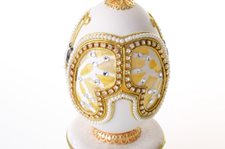
Peter Carl Fabergé crafted the most iconic and lasting symbols of Romanov Russia: fifty imperial Easter eggs commissioned by Tsar Alexander III for his wife Empress Maria Fyodorovna, and later by his son, Nicholas II, who continued the tradition of gifting ornamental eggs at Easter to his mother and wife, Empress Alexandra.
Fabergé learned his craft from his father, Gustav, who established the family’s Bolshaya Morskaya workshop in St. Petersburg, just a stone’s throw from the Winter Palace. Peter Carl, however, elevated the Fabergé name to international renown, making it synonymous with the opulent luxury of
fin de siècle Europe. The Fabergé workshops produced all manner of small objects made from precious metals and jewels, highly prized by European crown heads and nobility.
Much of the appeal of a Fabergé object was its intricacy and perfection: Peter Carl was reputed to keep a huge hammer by his worktable, and would think nothing of smashing a precious object - the result of months of painstaking work - to smithereens, if it did not measure up to his exacting standards.
The imperial Easter eggs represented the culmination of Fabergé’s craft and imagination. Each took months - some years - to design, often drawing on a particular event, anniversary, or aspect of the Tsar’s relationship with his wife and mother. Each egg was covered with enamel, or gold, and studded with precious jewels. Inside each egg, Fabergé cached a surprise or series of surprises, small objects made from gold, silver, crystal, and precious jewels.
The first egg, the “Hen Egg” was commissioned in 1885 for Empress Maria Fyodorovna, the former Princess Dagmar of Denmark, who had been fascinated by an 18th century enameled egg belonging to her aunt. The relatively simple design most resembles a real egg: gold covered with white enamel, opening up to a yellow gold yolk inside, and a teeny hen inside that. After the Hen Egg, the designs became increasingly complex, the surprises more intricate and amazing, including the memorable minuscule model train inside the “Trans-Siberian” egg, which, when wound with a tiny key, will still chug around for several minutes.
Fabergé was forced to flee Russia in 1918 to avoid persecution by the Bolsheviks, who nationalized the property of the Russian Tsars, selling many national treasures abroad to finance grain imports. The Fabergé eggs were scattered throughout the world: of the original fifty, forty-two survive today, many in American museums or in private family collections. Seven eggs, including the exquisite art nouveau Clover Egg, the Fifteenth Anniversary Egg, and Romanov Tercentenary Egg are on display in Moscow’s Armory Chamber, but until 2013, this was the extent of the eggs in Russia, and there were none in St. Petersburg.
Billionaire Russian businessman, Viktor Vekselberg decided to change this in the early 2000s. Paying a rumored US$100 million, Vekselberg purchased a collection of Fabergé eggs from the Forbes family and these today make up the core of St. Petersburg’s newest museum, dedicated to the decorative arts of Fabergé and other Russian masters. The museum was opened in 2013, housed in an exquisite former palace of the aristocratic Shuvalov family, which places the objects on display in a very appropriate setting. While the ten eggs on display, including the incomparable Lilies of the Valley Egg, the Imperial Coronation Egg, and the original Hen Egg, are a major draw, the museum’s other expositions are also very worth a visit to this welcome new addition to Russia’s cultural capital.
Visiting the Fabergé Museum requires special arrangements and advance booking. Speak to one of Alexander+Roberts knowledgeable reservation agents about how you might include this remarkable new museum on your program on Russian itineraries such as
Discover Moscow + St. Petersburg.